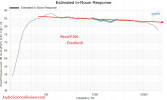DSJR
Major Contributor
Not terrible, but PLEASE folks, don't underestimate that nasty peak in the mid kHz region, which, if my brief listening memories are right (when it was briefly imported here), gives it an almost clinical, cold and chilly 'tone' in a lively room which may well be extremely clear and 'open mouthed' in high frequency delivery, but not strictly 'accurate' or 'long term pleasurable' by the standards set here, especially in a lively room with bare walls and a floor with barely a rug to its name as is popular these days.
Mind you, two to three grand a pair isn't so much these days and speakers I used to rate at around a grand the pair would be around this price now I suspect and maybe higher.
Do I spy electrolytic caps in the crossover too? That's a bit of a nono these days in 'audiophile' circles is it not? Maybe fine for the first ten years, but these things are going to be around a LOT longer than that I suspect?
Yes, I'm playing devil's advocate here, but just 'cos they're Revels (a little known brand here) doesn't mean they're automatically wonderful and beyond any criticism. Sorry and all that but...
Mind you, two to three grand a pair isn't so much these days and speakers I used to rate at around a grand the pair would be around this price now I suspect and maybe higher.
Do I spy electrolytic caps in the crossover too? That's a bit of a nono these days in 'audiophile' circles is it not? Maybe fine for the first ten years, but these things are going to be around a LOT longer than that I suspect?
Yes, I'm playing devil's advocate here, but just 'cos they're Revels (a little known brand here) doesn't mean they're automatically wonderful and beyond any criticism. Sorry and all that but...



